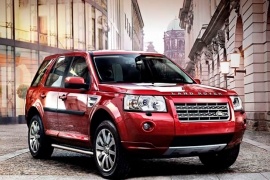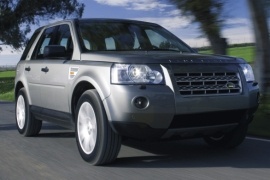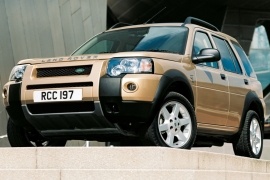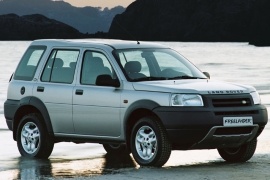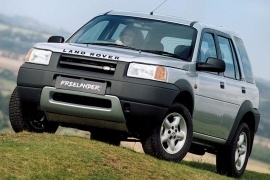LAND ROVER Freelander Models/Series Timeline, Specifications & Photos
First production year: 1998
Engines: Gasoline, Diesel
Body style: SUV (Sports Utility Vehicle)
While the first generation of the Freelander was built in cooperation with BMW, the second generation was developed together with Ford and improved in 2009.
When Land Rover started to built SUVs, the result was a more capable off-road vehicle than many off-road vehicles with low-range gear. The Freelander 2 was exactly that kind of vehicle. Its main advantage was the Terrain Response system, which enabled the car to transfer most of the engine's torque to the wheel with the most traction. And that was not just advertising. After Land Rover and Ford took different paths, the British carmaker improved its lineup, and that included the "Baby Landie."
The Freelander was already a known nameplate since 1997. The second generation was introduced in 2006 under Ford ownership. The 2009 model-year had to comply with the Euro 5 norms, and that included more than just a cleaner engine. From the outside, the Freelander 2 facelift featured new headlights with clear glass and a bolder grille. The rear taillights were changed as well, with rounded lamps under a clear-cover.
Inside, there were minor, aesthetic changes. The biggest evolution was made under the car's skin. There was a new climate control system that allowed it to function even with the engine stopped at a stop-light.
The 2.2-liter turbodiesel engine remained the main powertrain option for the European market. It was even installed on a 2WD version to improve the fuel-efficiency and decrease the CO2 emissions for the British brand. The terrain response was improved for the all-wheel-drive versions.
It was the second attempt made by Land Rover to build an SUV, and the result was a capable off-road vehicle that could put a shame on other 4x4 vehicles.
Land Rover Freelander was the last vehicle developed with Ford before the blue-oval carmaker sold its stakes to the Indian company Tata.
The platform was used for the Ford Mondeo and Volvo XC60 as well, but the result was better for the British brand. While its predecessor was built together with BMW, the Freelander's second generation was completely different, from tip to toe. It kept the overall look of a Land Rover, with a subtle bump over the rear side of the roof. Its big, rectangular headlights and the similarly shaped grille made the car looks tougher. The rest of the vehicle featured rounded edges and flat door-panels, narrower than the outer track. A set of plastic molding protected the lower side of the SUV.
Inside, the Freelander 2 offered enough room for up to five adults due to its clever platform. The designers installed a curved dashboard with a high center console. They put three large dials on the instrument cluster with four gauges and an LCD at the bottom. The rear bench featured a split-folding seatback to expand the already big trunk.
Land Rover opted for just two engine versions for the drivetrain: a 3.2-liter V6 and a 2.2-liter turbodiesel developed together with Peugeot-Citroen. It was paired as standard to a 6-speed manual, and there was an option for a 6-speed automatic. The vehicle's most important system was the “Terrain Response,” which could set the torque distribution between the wheels to offer the best possible traction available, depending on the surface.
In 1997 Land Rover was part of the BMW Group and introduced the Freelander as its first unibody SUV on the market. In 2003, it received a major facelift.
The Freelander was also known as the "Baby Land Rover" since it was the youngest and smallest car in its stable. Despite being an SUV without low-range gear, it was able to cope well in rough terrain with ease. Its BMW diesel engines and the Land Rover all-wheel-drive system worked well together, and the compact SUV was one of the best-sold 4x4 vehicles in Europe.
Like most of the facelifts, the Freelander received a new front fascia. That included new headlights, new bumpers, and new taillights. The redesigned bumper received a different pair of lights in the rear, less exposed to bumps and scratches. Land Rover didn't bother to paint the door handles and the moldings on the wheel arches in the same body color.
Inside, the Freelander received a new dashboard and instrument cluster. The designers installed a pair of cup-holders above the center stack. There was a new layout for the dials as well, with the fuel gauge and the coolant temperature placed between the speedometer and tachometer. Like its non-facelifted version, the Freelander featured a split-folding rear bench.
Under the hood, Land Rover installed a choice of gasoline and diesel engines. While Rover provided the gasoline units, the diesel version was powered by an especially tuned 2.0-liter turbodiesel built by BMW.
When BMW bought the Land Rover from British Aerospace, it found the Freelander as an almost finished product and worked only on the facelifted model, which appeared in 2000.
The first generation of the Freelander was longer than the Range Rover Series 1 and featured a longer wheelbase than the former company's flagship. It was a beloved car and, for five years, it dominated the compact-SUV segment, but it didn't do that alone. BMW helped it fixing the problems and, in 2000, it launched a refreshed version that included a German turbo-diesel.
Its exterior still looked fresh, but the management didn't want to go with the same image as the 1998 model, so it demanded some changes. At the front, the 2000 model sported new headlights with clear turn signals, but the massive black bumper with an integrated shield at the bottom remained. Depending on the trim level, the shield was either silver or body-colored.
The car designer, Gerry McGovern, struggled to find more interior room for the passengers. He forced the engineers to find a solution for the transmission tunnel to get a flat floor for the rear passengers. They couldn't delete it entirely, but they were pretty close. As a result, the Freelander was an actual five-seat vehicle fit for five adults.
Under the hood, BMW insisted on installing the German 2.0-liter turbo-diesel used on the BMW 3-Series. It was a far better option than the Rover's inline-four oil burner. It got higher power and improved fuel efficiency.
At the end of the '80s, Land Rover desperately needed a new product, and it developed it after British Aerospace bought the Rover Group in 1988.
The development program took almost a decade, but the Freelander exceeded the expectation. It became the most successful vehicle in Land Rover's history and market leader for five years in a row. But it wasn't developed with BMW, as some would think. The project was almost done when the German carmaker acquired the Rover Group in 1994.
Gerry McGovern signed the design, and it was a mix between an off-road vehicle and a compact station wagon. At the front, he installed the headlights up above the bumpers to protect them from bushes and other mild obstacles, shopping-carts included. The functional design worked well for the bumpers, where large areas of black, scratch-proof plastic were left unpainted. Its two-step roofline resembled the Land Rover Discovery shape. Both Frelander versions featured a power sliding window on the tailgate and high-mounted turn-signals.
Inside, McGovern designed an interior. He wasn't satisfied to stuff all the necessary parts and call it a day. He placed a significant number of storage places in and on the dashboard, in the door panels, in the center console, and a locking one in the trunk's floor. He convinced the engineers to find a solution, so the transmission tunnel was almost deleted, which helped achieve a great interior room, especially for the five-door version.
In the first production years, the Freelander featured Rover engines only: 1.8-liter gasoline and a 2.0-liter turbodiesel. Only the facelifted version was improved by BMW and enhanced with the German 2.0-liter turbodiesel unit.
